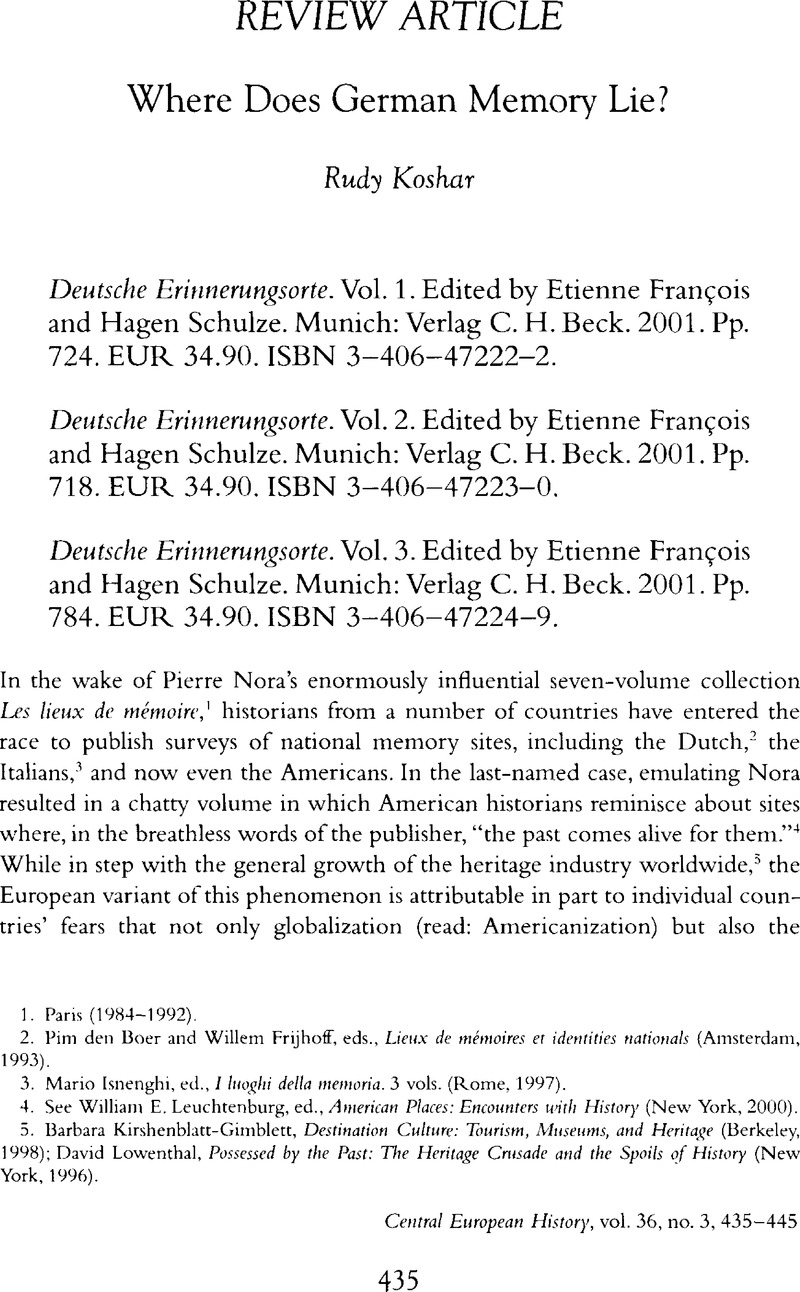Article contents
Where Does German Memory Lie?
Published online by Cambridge University Press: 16 December 2008
Abstract

- Type
- Review Article
- Information
- Copyright
- Copyright © Conference Group for Central European History of the American Historical Association 2003
References
1. Paris (1984–1992).
2. den Boer, Pim and Frijhoff, Willem, eds., Lieux de mémoires et identities nationals (Amsterdam, 1993)Google Scholar.
3. Isnenghi, Mario, ed., I luoghi della memoria. 3 vols. (Rome, 1997)Google Scholar.
4. See Leuchtenburg, William E., ed., American Places: Encounters with History (New York, 2000)Google Scholar.
5. Kirshenblatt-Gimblett, Barbara, Destination Culture: Tourism, Museums, and Heritage (Berkeley, 1998)Google Scholar; Lowenthal, David, Possessed by the Past: The Heritage Crusade and the Spoils of History (New York, 1996)Google Scholar.
6. Nora, Pierre, Realms of Memory: Rethinking the French Past, edited by Kritzman, Lawrence D., transl. Arthur Goldhammer, 3 vols. (New York, 1996–1998)Google Scholar.
7. See for example Assmann, Aleida, Erinnerungsräume: Formen und Wandlungen des kulturellen Gedächtnisses (Munich, 1999)Google Scholar; Assmann, Jan, Das kulturelle Gedächtnis: Schrift, Erinnerung und politische Identität in frühen Hochkulturen (Munich, 1992)CrossRefGoogle Scholar.
8. Nora, Pierre, “From Lieux de mémoire to Realms of Memory,” in Realms of Memory, vol. 1, Conflicts and Division (New York, 1996), xxivGoogle Scholar.
9. Koshar, Rudy, From Monuments to Traces: Artifacts of German Memory, 1870–1990 (Berkeley, 2001), 284–85Google Scholar.
10. Danyel, Jürgen, “Unwirtliche Gegenden und abgelegene Orte? Der Nationalsozialismus und die deutsche Teilung als Herausforderungen einer Geschichte der deutschen ‘Erinnerungsorte’,” Geschichte und Gesellschaft 24, 3 (1998): 463–75Google Scholar.
11. Gedi, Noa and Elam, Yigal, “Collective Memory — What is it?” History & Memory 8 (Spring/Summer, 1996): 30–50Google Scholar; see also Cole, Tim, “Scales of Memory, Layers of Memory: Recent Works on Memories of the Second World War and the Holocaust,” Journal of Contemporary History 37, no. 1 (2002): 129–38CrossRefGoogle Scholar.
12. Kirsch, Jan-Holger, review of Deutsche Erinnerungsorte, vol. 1, 18 06 2001, <http://www.hsozkult.geschichte.hu-berlin.de>>Google Scholar.
13. Raulff, Ulrich, “Heil dir im Kaffeekranz,” Frankfurter Allgemeine Zeitung (20 03 2001)Google Scholar.
14. One wonders, then, why the Brandenburg Gate and the Wartburg, both of which have attracted much expert discussion, are included in volume 2.
15. I borrow openly from Appadurai, Arjun, ed., The Social Life of Things: Commodities in Cultural Perspective (New York, 1986)CrossRefGoogle Scholar.
16. Consider for example the fascinating little volume by Oller, Franz-Josef, ed., Mein erstes Auto: Erinnerungen und Geschichten (Frankfurt am Main, 1999)Google Scholar.
17. Kirshenblatt-Gimblett, , Destination Culture, 273–74Google Scholar.
- 1
- Cited by


